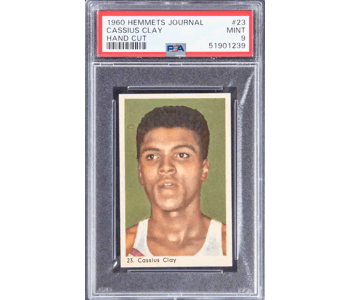
Affiliate Disclosure: Once you click on hyperlinks at Solely Greats & make a purchase order, we could earn a fee. As a free web site, we be part of associates like eBay & Amazon to assist offset our prices. THANK YOU on your assist!
Final Up to date On: November twenty first, 2024
One of many nice quirks about card accumulating revolves across the notion of a participant’s “true” rookie card. In lots of circumstances, a participant’s rookie card is the cardboard printed for his or her first yr as a professional. However in different circumstances – Michael Jordan’s, for example – a participant’s “true” rookie card, the one a lot of the interest considers their rookie, is printed after the very fact (and nonetheless hotly debated virtually 40 years later).
Whereas there are myriad explanation why a participant’s first skilled card could also be thought-about their “true” rookie, one of the widespread (and fraught) causes offers with whether or not the cardboard was pulled from a pack. In reality, there’s a rising sentiment throughout the interest that non-pack-pulled playing cards are much less invaluable or benefit much less consideration than their wax-encased counterparts.
On this put up, we’ll try to dispel the parable of the inferior non-pack-pulled card. First, we’ll spotlight numerous sorts, adopted by compelling examples of invaluable non-pack-pulled playing cards, and wrap up with a dialogue about why this fable persists. Finally, we hope to instill a greater appreciation for non-pack-pulled playing cards, as lots are worthy of our consideration.
Let’s dive in!
Overview
Earlier than moving into the varied kinds of non-pack-pulled playing cards, let’s make clear the distinction between a non-pack-pulled card and its counterpart. Right now, many playing cards are bought through packs: Blaster Bins, Hobby Boxes, Hanger Bins, and so forth. In different phrases, something sealed in plastic/wax is taken into account a “pack pull” since you’re pulling the person card from a pack.
However that’s to not say all playing cards are pack pulls. Neither is it the case that playing cards have at all times been pack pulls. On the interest’s daybreak within the nineteenth century, playing cards have been inserted straight into packs of bubble gum and cigarettes, with no wax or plastic in sight. In reality, it wouldn’t be till the Fifties that corporations started sealing their merchandise in wax and plastic.
On the opposite aspect of pack pulls are non-pack-pulls. Non-pack-pulls are playing cards (usually singles) which can be obtained by a technique apart from through sealed packs. Consider one thing like Topps Now, the place one purchases particular person playing cards on-line as they change into out there.
A key observe: this shouldn’t be confused with shopping for single playing cards on a web site like eBay. The important thing distinction is that each non-pack-pulls and pack pulls take care of uncooked, beforehand unowned playing cards, whereas shopping for by a retailer like eBay usually entails pre-owned single playing cards.
The Nice Delusion
Sadly, there’s a false impression that pack-pulled playing cards are extra invaluable merely as a result of they’re pack-pulled. Maybe it’s a matter of the randomness by which a pack-pulled card is acquired. Or possibly it seems like a purer model of accumulating (even when, as our historical past lesson above demonstrates, O.G. sports activities playing cards weren’t sealed in wax).
Regardless of the case, we’re right here to substantiate this isn’t true. Are we actually to consider {that a} serial-numbered Topps Now card is much less invaluable or fascinating than a non-numbered Prizm parallel simply because the latter was pulled from wax? It’s illogical!
Certain, there might be different components hampering a non-pack-pulled card’s worth. Many Topps Now playing cards are printed and offered in severely excessive portions. But, that is primarily a difficulty of shortage relatively than the truth that the Topps Now card wasn’t sealed in wax earlier than being opened.
When accumulating something, conventional components akin to shortage, high quality, and demand will inevitably rule the day over the place a card was acquired (except, in fact, the cardboard was obtained illegally). Even X-factors like a participant’s on-court success, charisma, and marketability possible play a much bigger position in figuring out a card’s worth than its standing as a pack pull. Uncommon and sought–after gadgets — be they a Michael Jordan rookie card or a primary–era iPhone — will at all times have worth.
To that finish, we’re glad that the parable of pack-pulled vs. non-pack-pulled playing cards is principally the province of ultra-picky collectors seeking to cut up hairs over minor components.
Kinds of Non-Pack-Pulled Playing cards
Now that we’ve differentiated between pack-pulled and non-pack-pulled playing cards, let’s spotlight just a few widespread examples of the latter. Whereas they’re much less widespread at this time than they as soon as have been, non-pack-pulled playing cards nonetheless proliferate within the interest and have offered the idea for a lot of extremely collectible playing cards in its historical past.
Hand Lower
Earlier than technological advances considerably improved the accuracy with which playing cards have been minimize, collectors needed to do the work themselves. These hand-cut playing cards have been usually gimmicks connected to cereal packing containers and magazines, designed to entice a buyer to buy mentioned product.

Discovering hand-cut playing cards in good situation is extraordinarily uncommon (it appears many collectors don’t have the arms or nice motor expertise to be surgeons). Given the shortage, plus the period during which hand-cut playing cards have been printed (usually pre-Sixties), there may be important worth available in hand-cut playing cards.
A few of our favorites embrace the 1960 Muhammad Ali #23 from Hemmets Journal (which is, weirdly, a Swedish homemaking journal). Others embrace the 1947 Nanina Ferenc Puskas, which honors one of many world’s biggest soccer skills, and the 1961 Post Cereal baseball set, which included stars like Roberto Clemente, Roger Maris, and Mickey Mantle.

Hand-cut playing cards are nonetheless widespread at this time. Maybe essentially the most well-known current instance is Victor Wembanyama’s first professional card, which appeared within the January/February difficulty of Sports activities Illustrated Children in 2023.
Star Co.
It could appear laborious to think about at this time, however within the Nineteen Eighties, basketball playing cards have been a no-man’s-land of alternative. When Topps’ license lapsed in 1982, Star Firm crammed the void with its personal set of basketball playing cards the next yr.
In consequence, Star Co. printed the primary skilled playing cards for gamers like Michael Jordan, Charles Barkley, John Stockton, Ralph Sampson, and Clyde Drexler. Nevertheless, what made these playing cards distinctive was the distribution technique: relatively than randomized wax packs, collectors might buy total group units. Accordingly, each collector who purchased a Bulls set in 1984 acquired a assured Michael Jordan rookie card.
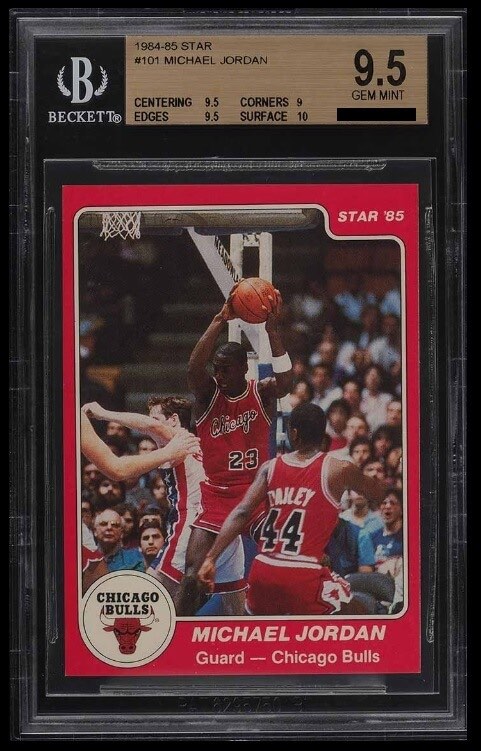
By 1986, Fleer owned the NBA license and offered basketball playing cards by interest packing containers. In consequence, the 1986 Fleer card was thought to be Jordan’s “true rookie,” regardless that it was not his first skilled card.
Star Co. went on to supply a litany of different units throughout its restricted run, together with Star Gatorade and Crunch ‘n Munch. Maybe not as cool on the time, these playing cards have a powerful classic issue and, given the corporate’s substantial printing problems, are pretty uncommon.
Topps Now
The most typical type of non-pack-pull playing cards at this time possible belongs to Topps Now. It’s an progressive card printing and distribution strategy that we mentioned (and largely panned) again in Could.
A subset of the Topps model, Topps Now presents patrons the possibility to buy particular person playing cards commemorating key moments in a participant or group’s season instantly as they occur. However these playing cards are solely out there for a restricted time, after which they’re by no means printed or offered once more by Topps.
It’s a enjoyable idea that appears to resolve a key drawback within the interest: ready for set updates and product releases. Within the case of Panini, which regularly doesn’t distribute its flagship model for six to seven months after the draft, the notion of getting a card instantly is engaging. A lot that even Panini Instant was born to compete head-to-head with Topps Now.
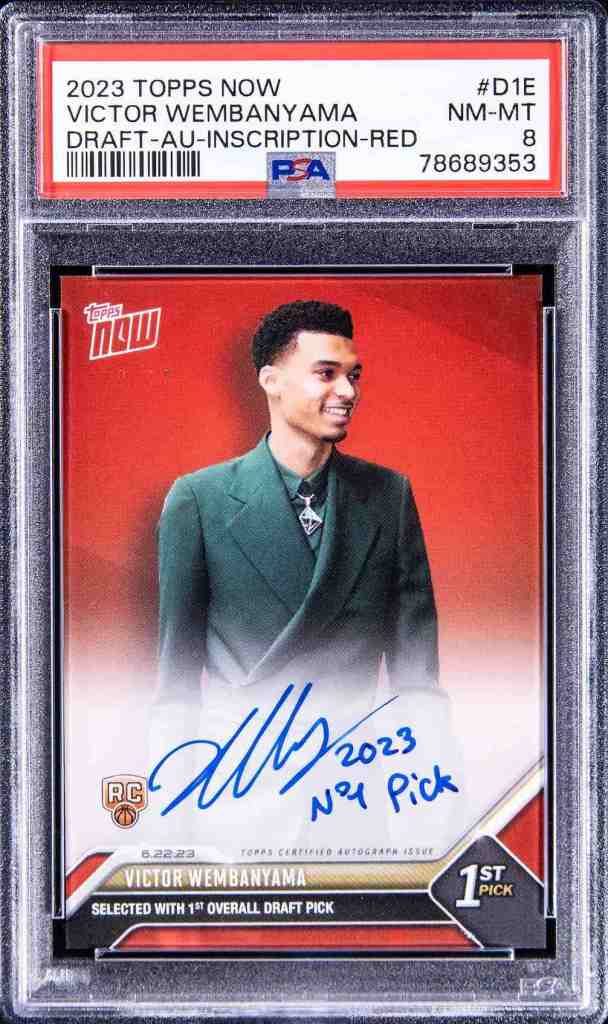
Nevertheless, many Topps Now playing cards endure from excessive overproduction. Take the case of Victor Wembanyama’s first Topps Now card, printed in honor of his draft into the NBA. Over the three days it was out there for buy, greater than 113,000 Wemby draft evening playing cards have been printed, shattering the model’s earlier print run file. With such a high pop count, the cardboard can’t maintain any important worth in the long term.
There is a crucial caveat, nonetheless. Not all Topps Now playing cards are made alike; in lots of circumstances, Topps Now will print a numbered parallel (or a number of parallels) to the bottom card that tends to carry some worth. For example, that Wemby draft evening base card could not have a lot worth, however the purple auto parallel numbered /10 sold for over $30,000 in October 2023.
Mail-in Redemption
One other widespread type of the non-pack-pull is mail-in redemptions. The method is pretty simple: As an alternative of receiving a card straight from a pack (or, within the case of hand-cut playing cards, from a field or journal), one receives a card within the mail from a card producer.
Right here’s the way it works: a collector purchases a pack of playing cards and pulls a “redemption card.” By no means seen one earlier than? Belief us, you’ll realize it once you see it. As an alternative of trying like a standard sports activities card, a redemption card resembles extra of a coupon, informing the proprietor that they’ll mail the cardboard to the producer to redeem it for an actual card.
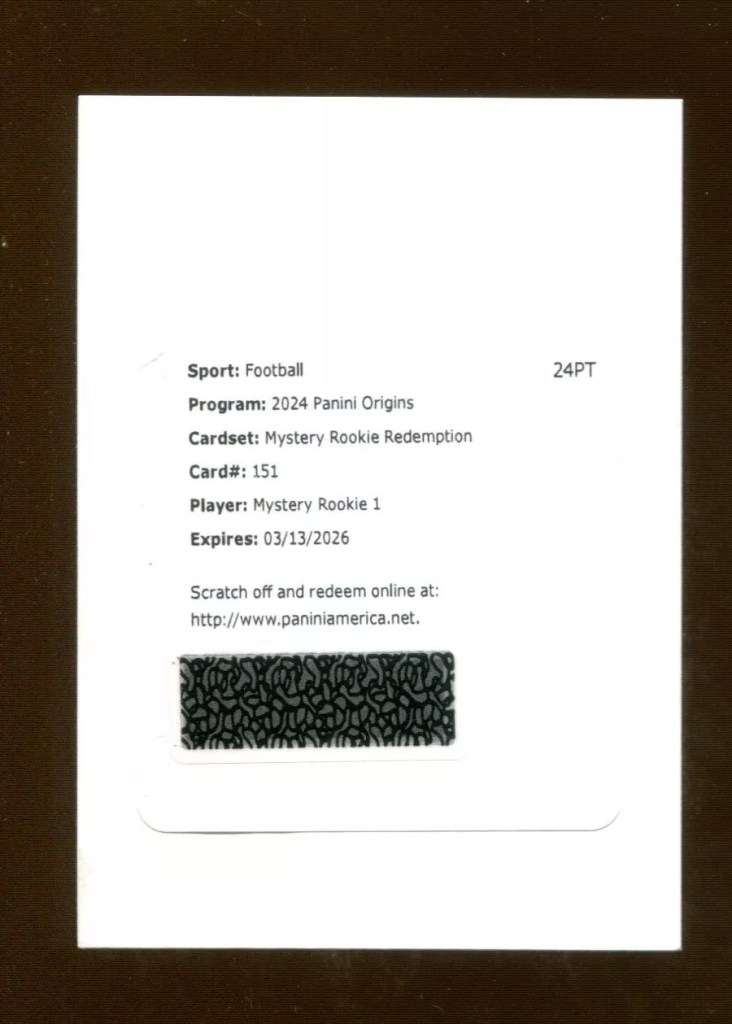
From there, the collector can mail the redemption card to the producer or, within the case of extra trendy redemption playing cards, submit the serial-coded quantity on the cardboard to the web site to redeem.
Mail-in redemptions are usually reserved for terribly uncommon and invaluable playing cards that might be misplaced or broken in a standard pack (or not prepared on the time of manufacturing e.g. an autographed rookie card that was not signed in time). Many redemption playing cards may be discovered on the market on-line, however collectors ought to train excessive warning when doing so. Given how simply they are often replicated, patrons ought to do their homework earlier than buying a single redemption card on-line.
Others
Box topper (or loader) playing cards are historically included as inserts within a wax field. They’re usually jumbo-sized relative to plain buying and selling playing cards, making them ultimate for becoming on high of wax packs (however not inside wax packs). One of the crucial invaluable field topper playing cards was the 1994 Collector’s Choice Box Topper Auto #23, that includes Michael Jordan throughout his minor league baseball stint.
Stickers have been a as soon as common different to sports activities playing cards, particularly with ’80s basketball gamers. The 1986 Fleer set contains notable Michael Jordan, Kareem Abdul-Jabbar, and Larry Chook stickers, whereas the flashy 1985 Prism Jewel set is a chromatic throwback together with related Corridor of Fame stars.
The important thing distinction between the 2 sticker units is that the 1986 Fleer have been pack-pulled inserts; each Fleer wax pack included one in every of 11 stickers, together with the Michael Jordan #8 rookie. Excessive-grade variations of those condition-sensitive stickers go for tens of hundreds of {dollars}.
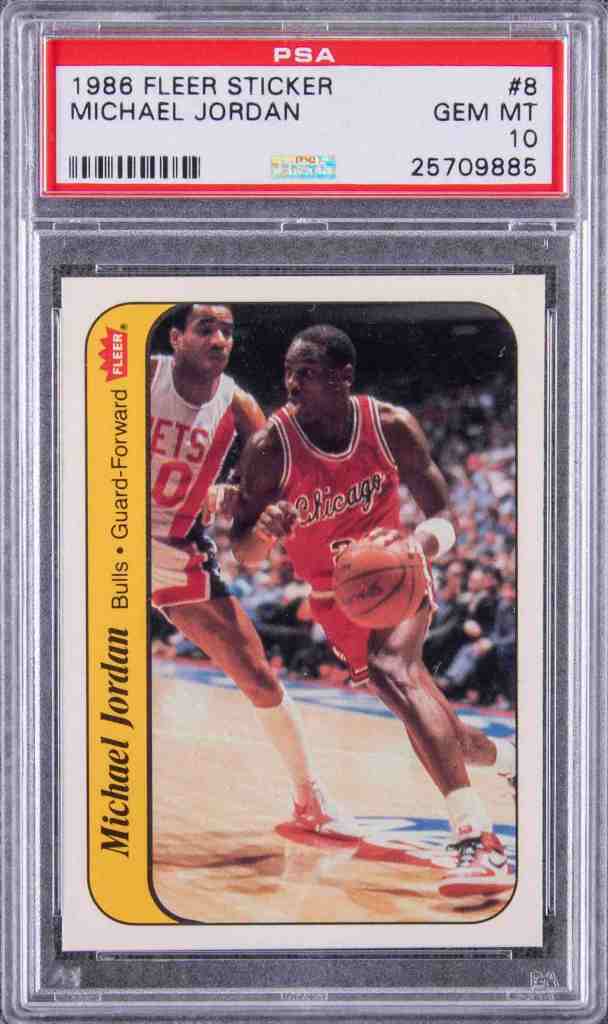
Alternatively, the 14-card 1985 Prism Jewel Stickers set was a merchandising machine product (sure, the sort you’d discover at your native retailer subsequent to the gum ball machine again within the ’80s). Even so, these non-pack-pulled stickers additionally promote for tens of hundreds of {dollars} in excessive grade. For example, this Jordan sold for $26,840 at Goldin Auctions in September 2024.
Switching gears, one other type of non-pack-pulled playing cards are the old-fashioned Bazooka playing cards. These got here in chewing gum packs packed proper alongside the gummy product itself. The 1963 “All-Time Greats” set contains icons like Honus Wagner and Walter Johnson. It’s not essentially the most invaluable set of Bazooka playing cards, however many different units (principally hand-cut from the field) can fetch very excessive costs particularly in excessive grades.
Lastly, full manufacturing facility units differentiated themselves from pack-pulls by permitting prospects to personal each single card in a given set. A number of the extra common full manufacturing facility units embrace the 2003 Topps (of which a child from Akron’s rookie card was included) and the Topps Traded Tiffany set from 1989 (of which a notable card from “The Child” was printed).
Most Useful Non-Pack-Pulled Playing cards
As we’ve demonstrated to date, many non-pack-pulled playing cards may be very fascinating, and invaluable, debunking the misunderstanding that they’re inferior playing cards. The next desk highlights a few of the greatest gross sales recorded within the final yr.
| Card Description | Sale Worth (Date) | Sort |
| 1984 Star #101 Michael Jordan PSA 8 | $244,000 (Sept. 2024) | Star Co. |
| 1994 UD Collector’s Alternative Michael Jordan Field Topper Auto #23 PSA 7 | $55,200 (Feb. 2024) | Field Topper |
| 2024 Topps Now Olympic Gold #26 Stephen Curry/LeBron James/Kevin Durant (#1/1) | $53,000 (Sept. 2024) | Topps Now |
| 1946-47 Nannina Figurine Tecnicolor Ferenc Puskas PSA 7 | $51,600 (Could 2024) | Hand Lower |
| 1985 Prism Jewel Stickers #7 Michael Jordan BGS 9 | $26,840 (Sept. 2024) | Merchandising |
| 1996 Sports activities Illustrated For Children Tiger Woods #536 PSA 10 | $25,800 (Nov. 2023) | Journal Perforated |
| 1960 Hemmets Journal Hand Lower #23 Cassius Clay (Muhammad Ali) PSA 8.5 | $18,300 (Dec. 2023) | Hand Lower |
| 1959 Bazooka Jimmy Brown SGC 5 | $9,600 (Oct. 2024) | Bazooka Hand Lower |
Abstract
The following time somebody tries to let you know that non-pack-pulled playing cards aren’t invaluable, you’ll be able to refer them to the chart above. Sure, these are the highest-end variations of those playing cards, however the math provides up.
Stickers and hand-cut playing cards are valuable due to their fragility and, by extension, rarity. The identical goes for old-school Bazooka playing cards that characteristic sporting heroes of yesteryear. Even Topps Now, with its trendy strategy to distribution, presents prospects the possibility to take house one-of-a-kind relics commemorating large occasions as they occur.
Whereas many collectors will nonetheless amass their collections via pack-pulling, there’s no flawed option to do it, particularly with non-pack-pulls. As we mentioned, there’s one thing pure about non-pack-pulls that harkens again to an period earlier than the interest turned extremely commoditized and professionalized.
Finally, non-pack-pulled playing cards aren’t simply nice investments; additionally they make stellar grail finds on your private assortment. Be it a hand-cut card or field topper, it’s enjoyable so as to add some variation to the PC. In spite of everything, what number of Prizm parallels do you actually want?
Associated
Trending Merchandise










